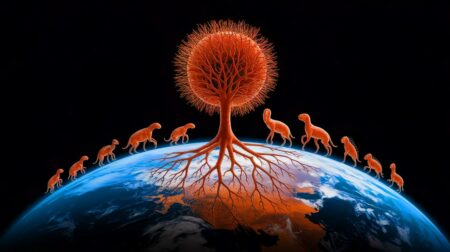| IN A NUTSHELL |
|
Millions of years ago, a remarkable predator roamed the North American landscapes, commanding the ecosystems with its extraordinary prowess. This formidable creature, known as the Epicyon, was not just any canid but the largest one to ever exist. With a jaw capable of crushing bones, the Epicyon thrived for millions of years. Yet, despite its dominance, this giant faced an unexpected challenge that ultimately led to its decline. As we delve into the story of the Epicyon, we uncover the fascinating traits that set it apart and the dramatic changes in the ancient world that shaped its fate.
Epicyon: A Canid Like No Other
Among the diverse array of prehistoric predators, the Epicyon stands out as the most massive canid ever known. Inhabiting North America from the early Miocene to the early Pliocene, this mammal shared little with today’s domestic dogs. Comparable in size to a brown bear, with a skull reminiscent of a lion’s, the Epicyon was part of a now-extinct subfamily of carnivores called borophagines, or “bone-crushing dogs.” These creatures possessed a jaw structure that allowed them to pulverize bones, a trait that distinguished them from modern canids like wolves and coyotes.
The Epicyon’s powerful jaw and carnassial teeth enabled it to access a unique food source—the marrow within the bones of large herbivores. Fossils discovered in the United States and Canada indicate that the Epicyon thrived in diverse environments, from grassy plains to dense forests, ruling over North American ecosystems for nearly fifteen million years. Such adaptability and dominance underscore the Epicyon’s significant role in prehistoric ecology.
Genetic Marvel Unveiled: These ‘Woolly Mice’ Bred from Mammoth DNA Stun Scientists Worldwide
A Formidable Predator with Unique Capabilities
Measuring around 8.2 feet in length and weighing approximately 276 pounds, Epicyon haydeni was the largest of the three known species of its genus. Its close relatives, Epicyon aelurodontoides and Epicyon saevus, while smaller, were still formidable carnivores capable of competing with modern wolves in size and strength.
The Epicyon’s anatomy was tailored for hunting large prey. Unlike early borophagines, which moved slowly on flat feet, the Epicyon walked on its toes (digitigrade), a posture that, along with a flexible back and small clavicles, allowed for impressive bursts of speed. Although it lacked the endurance of contemporary wolves, this deadly predator relied on swift, powerful strikes to catch its prey off guard.
Genetic Marvel Unveiled: These ‘Woolly Mice’ Bred from Mammoth DNA Stun Scientists Worldwide
Primarily a meat-eater, the Epicyon was an hypercarnivore, consuming over 70% animal protein. Its crushing molars, akin to those of hyenas, enabled it to chew and digest solid bones, an advantage unique among canids. Fossil analyses have revealed bone fragments in its fossilized droppings, confirming its extraordinary dietary capabilities. The Epicyon’s prey included massive herbivores like Aepycamelus, a camelid reaching up to 10 feet tall, and Teleoceras, a rhinoceros the size of a hippopotamus.
The Disappearance of the Epicyon: A Lost Battle Against Felines
Despite its prolonged reign, the Epicyon vanished around five million years ago. Its decline coincided with the arrival of a formidable competitor in North America: felines. Originating in Eurasia about 33 million years ago, the Felidae family crossed the Bering Strait, dramatically altering the predator landscape. The arrival of large felines, ancestors to lions and panthers, introduced several advantages over the borophagines. With retractable claws and powerful forelimbs, these cats had a decisive edge in capturing prey.
Water appeared just 100 million years post-Big Bang—A mind-bending rewrite of cosmic history
Some felines, like the saber-toothed cats, developed more efficient attack strategies, delivering fatal bites to the throats of their victims. Gradually, these new hunters supplanted the Epicyon in North American food chains, relegating the last borophagines to an increasingly narrow ecological niche. As the Epicyon and its kin disappeared, other canids adapted by specializing in endurance hunting, giving rise to the ancestors of wolves and domestic dogs. These evolved canids migrated to Eurasia, expanding their territories and leaving a lasting impact on the evolutionary history of canids.
The story of the Epicyon is a captivating chapter in the annals of prehistoric life, illustrating the dynamic interplay of competition and adaptation in the natural world. As we reflect on the rise and fall of this giant canid, we are left to ponder the intricate forces that shape the survival and extinction of species. What other remarkable creatures lie hidden in the depths of our planet’s history, waiting to be discovered?
Did you like it? 4.5/5 (26)









Wow, imagine bumping into one of these on a hiking trip! 😂
Umm,imagine that
How do scientists know so much about the Epicyon’s diet?
Depending on if they found some in ice or in a tarpit that had bones and or what remaining of where their stomach should be they can find stuff in there
Because it had eaten some of them
You got it, just fake news. Media makes money out of it.
When the title reads “its back from extinction” I expected it to have actually been revived like the dire wolf
This article is fascinating! Thanks for sharing such a thrilling piece of history. 🦴
This article is great but also a bit terrifying. I can only imagine and worry what scientists are already doing. The thought of even 1, let alone a breeding pair, ever being created is absolutely terrifying. They are extinct for a reason. To bring carnivores such as this back to life could be the beginning of our extinction. We are moving this along without massive creatures to help us along
Great bit of news Maddie,it even reached my Google news feed here in a small town in the UK , me at be such a rare find
Really cool article, but where’s my time machine when I need one? 🕰️
I have to admit, I had never heard of the Epicyon until today. Thanks for the education!
How reliable are the fossil records for determining the behavior of extinct species?
Have the scientists found whole skeleton or just partial and guessed at the rest?
My thoughts exactly.
Not sure I buy into all of this. Sounds a bit too much like a Jurassic Park plot. 🤔
This makes me appreciate modern-day wolves even more! They had some fierce ancestors.
Why did the Epicyon go extinct but not other canids?
Lots of other canids went extinct.
So, did felines really outcompete them, or was there more to their extinction?
Love how nature always finds a balance, even if it takes millions of years! 🌿
Another great article that makes prehistoric times sound like an epic adventure movie!
Is there any chance that some of these bone-crushing dogs could still exist in remote areas?
Did I read that right? They could crunch bones like a potato chip? Amazing!
Reading this made me glad I only have to worry about coyotes in my backyard. 😅
Could the Epicyon’s diet provide insights into its behavior and social structure?
This piece reminded me of how much there is still to learn about Earth’s history!
Would love to see a documentary series about these ancient predators!
What a shame they went extinct. I bet they’d be quite the attraction at a modern zoo! 🐾
Thanks for the detailed article! I learned so much I never knew about prehistoric life.
Does anyone else feel like nature is way more creative than any fiction writer?
I’ve thought that for a long time. And not just nature. If one believes in a God who set the creation of the Earth in motion to evolve on its own, with maybe a little a tweaking from above, it’s still a pretty amazing place. He kept us here with a lot of conundrums to figure out. It doesn’t keep us out of trouble, but it keeps us busy.
I wish the article touched more on what led to the evolution of felines that outcompeted them.
Intriguing read, but I’m still left wondering about their social dynamics.
Can we really use fossilized droppings to learn about an animal’s diet? Sounds gross but cool!
Isn’t it amazing how much we can infer from just bones and fossils?
I’ve always been fascinated by prehistoric animals, and this article did not disappoint! 🦖
The more I read, the more I realize how much we don’t know about our planet’s history.
What would the Epicyon’s roar sound like, I wonder?
Great article! Makes me wonder what other giant predators lurked around back then.
How did the Epicyon compare to the dire wolf?
It must have been terrifying to be prey for one of these creatures!
Does anyone else think the Epicyon would make an epic movie monster? 🎥
Absolutely! It’s like you read my mind. I couldn’t tell from the article, but is sounded like they hunted alone. Can you imagine a pack of those things on the attack?
Thanks for this insightful read! Makes me appreciate the complexity of evolution.
Are there any close living relatives of the Epicyon today?
Are there any efforts to bring back the Epicyon, like with woolly mammoths?
I wrote a screenplay that features this ferocious beast. It was more vicious than any lion or tiger on our planet.
So, basically, the Epicyon was the original “wolf of Wall Street” in the animal kingdom? 😂
Interesting read, but I wish there were more visual aids or illustrations of the Epicyon.
I wonder what modern animals would have coexisted with the Epicyon if it were still around today.
It says it’s Back!! Well where the hell is it then!! 😫
Who’s feeding him! and picking up his woopsies😂😂
How many times does it get walked a day!!😬 and is it a banned breed😂😂
They don’t half talk some crap!! 😵💫😵💫😵💫😵💫
Imagine using an AI picture and calling it a “reconstruction”. It’s not even close to the skeleton. Could’ve put a picture of a Rottweiler up and it would’ve been closer
Click bait after the dire wolf story came out, not actually coming back…….
And at no point in the article does it say what the title is
Click bait at its worst
These people need to be stopped
I have one for a pet. His name is Rusty. He is as gentle as a lamb, He breaks his chain when hungry and a sheep 🐑 rancher complains Puma’s have been eating his sheep. Rusty comes home and burps up bones and white stuff. Hmmm
Have the scientists found whole skeleton or just partial and guessed at the rest?